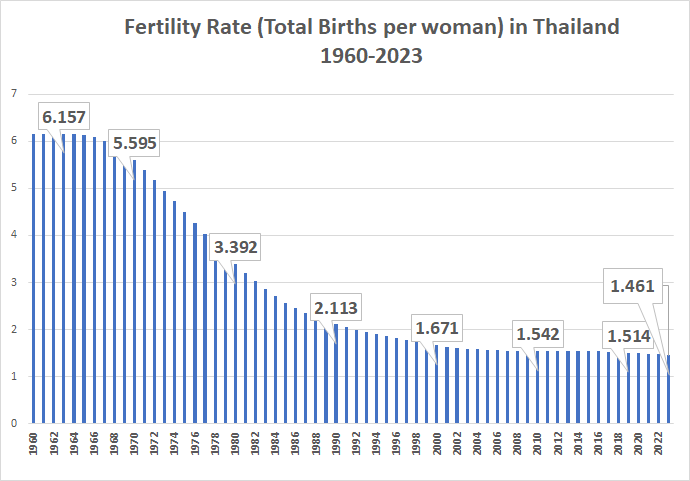Fertility Rate in Thailand : A Nation in Decline?
Extra Demographic Update 2022 at bottom page.
Update this page End 2023.
A developing country (often also a 'poor country') is usually thought off as having high birth and fertility rates. Thailand has past this stage, and fertility has been declining rather dramatically over the past few decades. In the early sixties total fertility rate was still 6.5 children/woman(!!!). Partly as the result of a National Family Planning Program (NFPP), fertility had declined to 4.9 children/woman in 1975. By the early 1980s it had declined to below 3.
A survey of fertility in Thailand for 1996 shows an average number of children per woman of 2.14 . In 1996, Bangkok Metropolis and the Northern Region already had a below-replacement fertility rate.
The data on the graph below are provided by the World Bank (surely derived from Thai sources). From 2020, data are provided by Macrotrends.net . The 2023 estimate is from the United Nations.
The graph shows a fertility rate of 2.11 in 1990, which if remaining at this level, was enough to keep an about constant number of Thai citizens. Afterwards, the fertility rate decreased further and formed a low plateau at just above 1.5 childern per woman in the last decade. No major changes seem to occur from year to year lately. The fertility (World Bank) for 2019 was 1.514 children per woman.
In 2020 the fertility rate was 1.505 children per woman, in 2021 the fertility rate was 1.491, in 2022 it was 1.476. For 2023, the United Nations predict a fertility rate of 1.461. So a slow but steady decline for the last few years. Interestingly, the United Nations (with whatever logarhythm predicts a rise of the fertility rate to around 1.7 in the next few decades.
So, these data show no relevant influence of the Covid-19 Pandemic on fertility. One could make arguments for an increase (people are more at home together) and a decrease (what is happening to the world ?). See comments at bottom page.

A fertility rate around 1.50 is way below the generally accepted level of 2.1 children born per woman necessary to maintain current population levels in the long-term.
We need maybe to throw in some demographic mathemathics here. A low fertility rate does not mean that the population is declining at this moment. As long as the death rate is lower than the birth rate, the population will increase, and as of 2020 the populations of Thailand is still increasing. Now why is the death rate still lower than the birth rate? Well, there are still less old people than young people, and it are mostly old people that die. When the size of the older population increases in the next few decades, there will come a time when the death rate surpasses the birth rate, and the overall population will decline. [Japan has reached this stage in 2006] Mentally, Thailand is slowly preparing itself for times to come. The population is already aging rapidly. To the Western eye this is not always visible. You still see lots of children around, and adults still bring them from time to time to their place of work (since there are hardly any affordable nurseries). On the other hand, old people seem to be hiding themselves. It must be that most of them stay most of the time at home and are being cared for. It must be said there are hardly any allowances given to retired or old people in Thailand, and this may become a bigger problem in the future.
At least, since there are hardly any retirement homes in Thailand, and old people are being cared for at home, the country did not suffer the indignity of having his older generation dying by the thousands in nursing homes as happened in Western societies, with the Covid-19 virus pandemic.
We think the declining fertility rate is a serious problem, and as in most countries (especially Western Europe, Russia and Japan) this problem is not addressed, and even hardly mentioned in the media. For a long time it was thought that women were just delaying having children, and that fertility would pick up or at least stabilize, when they were getting children in their mid-thirties or even later. However, time has learnt, that it was not a question of delaying to have children, but in many cases a choice to go without them.
In the long-term we think that a low fertility rate will bring about drastic changes. Having a relatively young population is important to maintain the dynamism and creativity of society. It is doubtful that this somehow can be counteracted by computer technology. Societies may become very conservative and ultimately stagnating.
What brings about these changes. Well, initially they were certainly initiated by government policies (also in Thailand). At present, we suggest that simple materialism is the root of the problem. This works in at least two ways. First, while still loving children and finding them very 'cute', a lot of young adults simple prefer to spend time chatting on their mobile phone, driving an unneccessary car, and holidaying. No time for changing diapers in this type of schedule. On the other hand, the cost of raising a child are much higher than before, because the expectations of what one is supposed to 'give' to a child are so much higher. It was not quite necessary to pay for piano lessons in the 1950s. To keep a sufficient living standard for families, women are participating in the labor force in ever larger numbers, and certainly this limits room for large families.

No place for young girls anymore in Thailand?
Besides the overt materialism on a personal level, in Bangkok we have to observe that society has hardly spent any effort in creating a child-friendly environment.
There are no open spaces in Bangkok where children can roam around and play. As an example of how wrong this is, I noticed a few times that children are learning to bicycle on the grounds around the condo where I live, while the parents are anxiously observing their children, as well as scanning the street for any approaching vehicle. I do not know of any playground within walking distance.
[related to this : Where are the open air sport facilities in Bangkok? You will have to search a lot to find a place where you can jog around a track, and what about public swimming pools? No wonder that Thailand has so few well known sportsmen (except for Thai boxing and weightlifting, sports that are practiced indoors).]
There are many high-rise building in Bangkok. By law, condominiums have to provide parking spaces for the vehicles of its residents. As a result, often the first 5 or 6 floors of a building consist of parking lots. It is something to think about that properties have so much space reserved by parking cars, but on the other hand there is hardly any space allocated as a playground for children. This goes hand in hand with a lack of 'green space', and it would actually be a good idea if laws where available that obliged companies to always include gardens and playing grounds into property developments.
Add-on

What I noticed at my condo, where many Japanese young couples reside, is that most of them have a good number of kids (much more than I would think in view of the low fertility of women in Japan), as can be seen here with the assortment of little bicycles and the like from just 2 families, parked outside their apartments.
Demographic Update 2022
The data below may be accurate or not. We found them in 2021 on the website of the National Statistics Office of Thailand. However, the data could not be recovered end 2023 (the website itself does not show comprehensive data). We left it here, maybe someone can find a conspiracy somewhere ?
2021 has become the first year during which deaths outnumbered births in Thailand. According to the National Statistics Office, there were 563,650 deaths vs. 544,570 births.
Looking at the data in detail, there has been a dramatic fall in births from 702,058 as recent as 2017 to 544,570 in 2021. In 2019 there were 618,193 births and in 2020 there were 587,368 births. Most certainly, the total fertility rate now (despite numbers provided by NSO elsewhere) is way below 1.5 Another observation : it is quite possible that because of the Covid-19 Pandemic, that some parents have elected not to have children at this time. We are curious about statistics in various parts of the world, regarding this issue. Certainly, there has been (is) a lot of fear going around, not in the least as created by government agencies.
The number of deaths in Thailand from 2012 to 2020, seems to be increasing steadily from 423,213 in 2012 to 506,211 in 2019. There were 501,438 deaths in 2020. Increasing death numbers can be expected with an aging population, after all, we do not live forever. However, deaths increased dramatically for 2021, up to 563,650. Not coincidentally, 2021 is the year when Thailand suffered the most deaths related to Covid-19 (delta-variant). As of 7 February 2022 there have been 22,294 casualtied due to Covid-19. More than 20,000 occurred during 2021. If looking at the death numbers for 2021, it seems possible that deaths related to Covid-19 have been underestimated.
So dramatically less births and dramatically higher death rates, have created a decline in Thai demographics. But, we can hope, that these changes can be reversed, with more births in 2022, and less deaths in the same year

